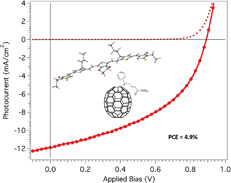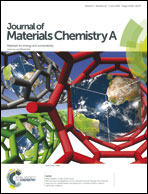High photocurrent in oligo-thienylenevinylene-based small molecule solar cells with 4.9% solar-to-electrical energy conversion†
Abstract
A set of five novel oligo-thienylenevinylene organic molecules have been synthesized and characterized for use as electron donor moieties in bulk-heterojunction solution-processed organic solar cells combined with PC71BM as an electron acceptor. The results show a broad range of solar-to-electrical conversion efficiencies, with values up to 4.9% achieved with a photocurrent value as high as 12 mA cm−2 under standard measurement conditions. Moreover, another aim of this study was to determine the main limiting processes that control the final performance parameters of these devices. Photo-induced charge transfer measurements, such as charge extraction (CE), Transient Photo-Voltage (TPV) and mobility measurements, were carried out in order to determine the main loss mechanisms and to correlate them with the electron donor molecular design.


 Please wait while we load your content...
Please wait while we load your content...